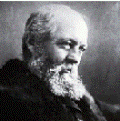
Frederick Law Olmsted (1822 – 1903)
Frederick Olmsted was a landscape architect before the profession was founded. He was a visionary who foresaw the need for national parks, devised one of America’s first regional plans, and designed America’s first large suburban community.
Although Olmsted is famous today for his landscape architecture, he did not discover this career until he was 35. During his youth, Frederick Law Olmsted pursued several professions. Olmsted became a respected journalist and social commentator. Traveling through the southern United States, Olmsted wrote treatises against slavery. Olmsted’s book A Journey in the Seaboard States was not a great commercial success, but was highly regarded by readers in the Northern United States and England.
Olmsted joined with English-born architect Calvert Vaux to enter the Central Park design competition. Their plan won, and the pair worked as partners from 1865 to 1872. Together they designed many parks and planned communities, including Riverside, Illinois, which is known as America’s first modern suburb.
After Olmsted’s death, his stepson, John Charles Olmsted (1852-1920), his son, Frederick Law Olmsted Jr. (1870-1957), and their successors continued the landscape architecture firm Olmsted founded. Records show that the firm participated in 5,500 projects between 1857 and 1950.
Notable Buildings:
United States Capitol Grounds
Many College Campuses
Biltmore Estate Gardens and Grounds
Central Park in New York City
Riverside community in Illinois
Frederick Law Olmsted’s Partnerships: